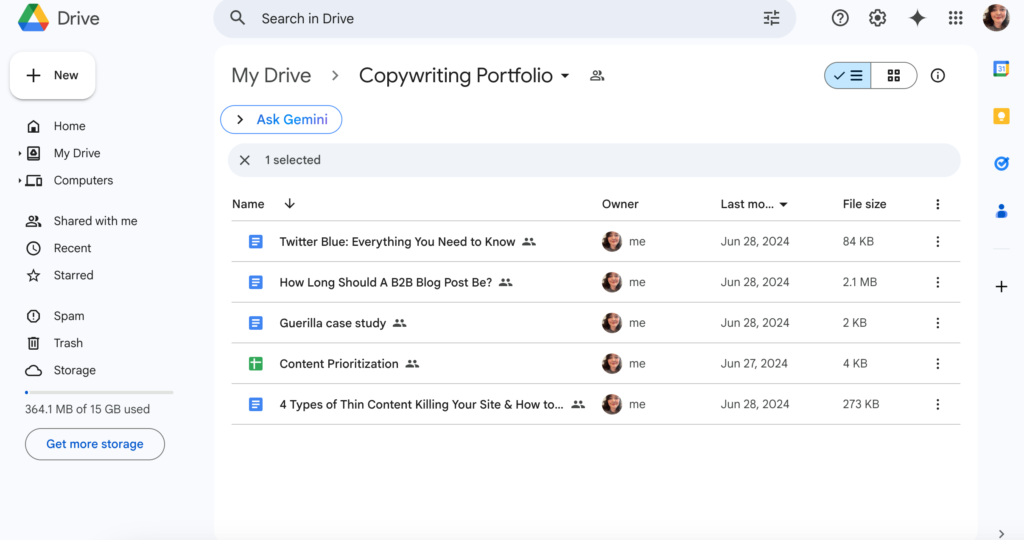How To Get A Marketing Job With No Experience
So, you want to get a marketing job but don’t have any experience?
Five years ago, I was exactly where you are now. I had a totally different career, an unrelated degree, and no experience in marketing.
But, I learned anyone can get a marketing job with the right strategy.

While there’s not an overnight fix, there are many ways to gain experience in marketing and eventually get that job.
And, you could even make money along the way.
Changing careers or getting your first ever job in marketing isn’t impossible–even if you don’t have the right degree or professional experience.
Anyone can get a job in marketing, whether you want to freelance or get a stable 9-5 job.
You can get a marketing job with no experience – How I did it
Yes, it is possible to get a marketing job with no experience. Here’s how I did it:
I got lucky because I already had 10+ years of blogging experience by the time I realized I needed to change careers from being a librarian. Blogging is what made me discover SEO in 2018, which opened up the entire world of digital marketing to me.
When I decided it was time to change careers, I found apprenticeships that led me to some freelance work (and I wrote for a content mill–eek!)
My first marketing roles came through the Acadium platform. With Acadium, you can connect with a small business or agency that needs free marketing work, get a mentor, and work with them for 3 months.
I had some amazing mentors, as well as some who helped me learn how to spot a difficult client. I learned how to blog correctly for SEO, how to write for LinkedIn, how to repurpose content, and how to execute a lead generation campaign.
I used my blog to prove I had a strong foundation in writing, which helped convince potential mentors that I could write in different niches and formats.
I was able to use these experiences as freelance experience on my resume, as well as include testimonials on my new writer website, and use my mentors as job references.
After doing this for a couple of years, I was able to change careers and land my first official marketing role.
If you want to know what I’d do differently and use that to speed up the process, here are the steps you should take.
Step 1: Do apprenticeships or internships
Internships and apprenticeships are a valuable way to get marketing experience.
They’re often for shorter time frames, which can be helpful if you want to gain a variety of experience quickly. This can also make it easier to manage alongside a full-time job.
I’ve personally only used Acadium for apprenticeships, so that’s the only apprenticeship program I feel confident recommending.
Here are my thoughts on Acadium:
Acadium
Acadium matches aspiring marketers with businesses who want a couple months of free work. Some are interested in taking their apprentices on full-time, but that’s not a guarantee.
With Acadium, you can work for a variety of businesses, including:
- Marketing agencies
- Startups
- Coaches
- Psychics who have been on The Real Housewives of Beverly Hills (true story)
- Creatives
You can select what you want to get experience in, and that’s used to match you with someone.
It’s valuable if you want to gain experience in multiple marketing channels and create real projects to add to your portfolio.
It’s also helpful to learn what types of marketing you don’t like.
At the end of each 3-month apprenticeship, you’ll get a review that you can use as a testimonial (with permission).
Step 2: Create a portfolio
All full-time jobs will ask for a portfolio, often showcasing more than one type of work. They may ask for anything from blog posts to ad copy to case studies.
Having work in different formats will allow you to create specialized portfolios for each job.
But can you create a portfolio with no experience and no published work? Absolutely.
Here’s how:
Start a blog
Starting a blog is a great way to store your work. You can show that you have the ability to write about different topics, which will showcase your research skills as well.

Being able to share growth in web traffic is powerful in a portfolio, but not essential depending on the job you’re applying to.
With a blog, you can demonstrate your skills in:
- SEO
- Writing
- Content distribution
- Social media management (for associated accounts)
- Content repurposing (turning blog content into visual or video content)
- Writing in a specific niche (or multiple niches)
Writing on a blog will also show potential employers your writing and communication skills.
If you write a blog on marketing topics or content related to your niche, you’ll also show your knowledge in those areas.
Use Google Docs
You don’t need a blog to showcase your work.
A Google Doc with your writing pieces works as well.

You can write content in the industry you want to work in using different formats (landing pages, blog content, case studies, emails, etc).
Check out this resource on choosing your industry.
You can also explain your process for creating the work.
Start a social media account
While starting a personal Instagram or YouTube account is very different from managing a business account, doing so can demonstrate how you would apply those skills to a business account.
Starting your own account will teach you valuable skills including:
- Audience research
- Community engagement & management
- Influencer collaboration
- Social media analytics
- Script writing
- Social media copy (captions)
Growing a social media account organically is tough, but even if you grow slowly, it’s still a strong demonstration of social media skills.
Start posting on LinkedIn
Think LinkedIn is cringe? So do most people.
But it’s invaluable if you’re selling your own services or trying to connect with potential employers.
Only 1% of LinkedIn users of 310 million active users actually post content. That means less competition and more views.
More appearances on LinkedIn means more appearances on search, which companies use to find freelancers or potential employees.
You can boost your visibility by posting just once a week.
Not sure what to write about? Here are some ideas for marketing newbies:
- Read marketing books & share your thoughts
- Share what you learned from courses
- Write case studies of how you’d grow a startup or small business
- Rewrite landing pages and share why they work
- Comment on other people’s posts & ask questions
As an aspiring marketer, your objectives should be visibility, networking, and learning.
Don’t think that just because you’re new you don’t have insights to offer.
Need more advice? This is what NOT to do on LinkedIn:
- Use AI to write your posts
- Use AI to write your comments
- Not write in your voice and sound stuffy
LinkedIn may be a professional platform, but a lot of the content is the same. And, people tend to be afraid to write in their authentic voice.
If you can show some personality (while still keeping it professional), you’ll stand out and get people to like, know, and trust you.
You can also use LinkedIn’s “About” section to tell companies what skills you have, what you’re looking for, and highlight relevant experience. The “featured” section is great for linking your strongest portfolio pieces.
Step 3: Learn popular tech
Learning popular tech may be challenging if you’re just starting out and aren’t able to pay for a $100+ subscription to Ahrefs or Semrush.
The good news is that many big-name marketing tools have their own YouTube channels. You can use these to get the basic strategies for using these tools.
You can also follow marketers on YouTube in the position you want and see how they use the tools to inform their strategies.
Your ability to learn software and how to apply it in the job is something you can include in a cover letter.
You should learn about software used for niches including social media, SEO, automation, AI, and email marketing.
Popular marketing technology I recommend learning about includes:
SEO
- Ahrefs
- Semrush
- Google Search Console (great for bloggers)
Social media
- Later
- Hootsuite
- Buffer
- CoSchedule
CRM (customer relationship management) & CMS (content management system)
- HubSpot
- WordPress
Email marketing
- MailChimp
- Kit (formerly ConvertKit)
Automation
- ActiveCampaign
- Zapier
AI
- Jasper
- ChatGPT
- Claude
If you do an apprenticeship or internship, you’ll likely gain access to some of these tools. That’s why completing apprenticeships in different marketing niches like social media or SEO can be really helpful for anyone looking to change careers to marketing.
Step 4: Analyze your transferable skills
You don’t have to have direct skills in marketing to get a marketing job.
Your soft skills can be used in many marketing jobs, so you should analyze the transferable skills you have for marketing.
Here are some skills commonly found in marketing job descriptions:
Project Management
Running marketing campaigns requires strong skills in organization and communication.
Project management will help you create realistic timelines, come up with solutions to problems, budget, and stay on top of deadlines.
It’s important to know how to manage both a project and the teams involved.
Cross-Departmental Collaboration
You won’t be creating marketing campaigns on your own. You’ll probably be collaborating with other departments to make them more effective.
To effectively collaborate, you have to be able to explain marketing concepts to any audience.
This means explaining how your efforts support theirs and help them meet their goals.
For example, you may collaborate with sales to create sales materials. You’ll also use their data to inform future campaigns.

Data Analysis
Data analysis will help you prove the need for marketing to stakeholders and leadership.
It’ll also help you figure out what’s working and what’s not and adjust based on data.
If you have customer service experience, you may be familiar with keeping track of daily sales and email signups at checkout.
Or, if you’re changing careers from teaching to marketing, you can talk about how you use data to understand gaps in student skills.
Customer Success
Applying to an agency role? Having a positive attitude with customers will help you get that job.
Some marketing roles require customer interaction, whether in the form of organizing webinars, managing clients, or interviewing customers.
Knowing how to answer customer questions, communicate results, and make recommendations in a way they understand will lead you to marketing success.
Presentation Skills
To get leadership to back your ideas, you’ll need to be able to present confidently using data they’ll understand.
Not every business leader is receptive to marketing ideas, especially if it’s something they haven’t tried before.
Appearing confident and knowledgeable is half the battle.

Adaptability
90% of job descriptions I’ve looked at require the ability to adapt to changing priorities.
Good examples to use include:
- The ability to learn and apply new skills
- Problem solving skills under pressure
- Applying new trends to your strategies
- How you adapted to a change in leadership
How can you talk about these in an interview?
Here are some examples from my former role as a librarian.
I once had to give an on-camera statement when we received a donation, and hadn’t been told in advance.
I had to appear calm and collected even though I was nervous about not having a script.
It was also common to be moved to different libraries where I worked, so I had to get used to changing managers. I learned how to manage up and make my manager’s job easier.
For instance, at one location, I had to perform tasks outside of my job description when someone in that role left the company.
This taught me to learn quickly and be more flexible as a librarian. It ended up being helpful when subbing at other locations because I could sub in for any role, not just as a librarian.
Time Management
Time management is necessary for literally any job.
In a marketing role, you might have pre-assigned tasks. However, it’s also common to get ad-hoc tasks, or tasks that aren’t planned in advance.
Priorities constantly change in marketing based on the effectiveness of campaigns or changing business goals. Being able to manage time will keep you on track with ongoing projects and new ones.
Step 5: Keep your job search organized
Keeping your job search organized is the best way to prepare yourself for interviews.
You should create a system that includes information such as:
- The job description
- The salary information
- Point of contact
- Number of interviews/hiring process (if available)
- The resume & cover letter you used to apply
- Practice interview questions
- Interview questions you had trouble answering
- Answers to questions you asked at the end of the interview
- Notes from interviews
Notes from the interview can include the vibe you got from the interviewers (do they seem stressed, do you get a bad vibe, do you like the person).
You can keep this information in a Google Sheet or in Notion.
I use this free Notion template.

Step 6: Continuous learning
If you don’t have a relevant degree or experience in marketing, the first thing you should do is take courses and get certifications from industry heavyweights.

And don’t just stick to one field, either. You’ll be way more valuable to companies if you understand how different marketing channels work together.
Here are some certifications I would recommend:
Google’s digital marketing certification
I haven’t taken this one myself, but I really wish I had started with it.
Google’s digital marketing certification is the perfect place to start learning.
You can get started with Google’s Digital Marketing & Ecommerce Certification.
HubSpot certifications
The great thing about HubSpot certifications is that they’re free. Plus, there are a TON of them.
And, these certifications are 100% free.
Here are the certifications I would recommend for beginners:
- Inbound Marketing
- Content Marketing
- Digital Advertising
- SEO
Meta Blueprint
The courses for Meta Blueprint teach you how to engage with and attract customers using Meta tech (Instagram and Facebook).
Their certifications include:
- Digital marketing associate
- Marketing science professional
- Creative strategy professional
- Media buying professional
- Media planning professional
- Community manager
If you want to become a social media manager, these courses should be your top priority.
Resources for getting a job in marketing
Want to check out the resources I mentioned?
Here they are:
Apprenticeships:
Marketing Courses:
Hubspot Courses
Meta Blueprint Courses
Google Certifications
